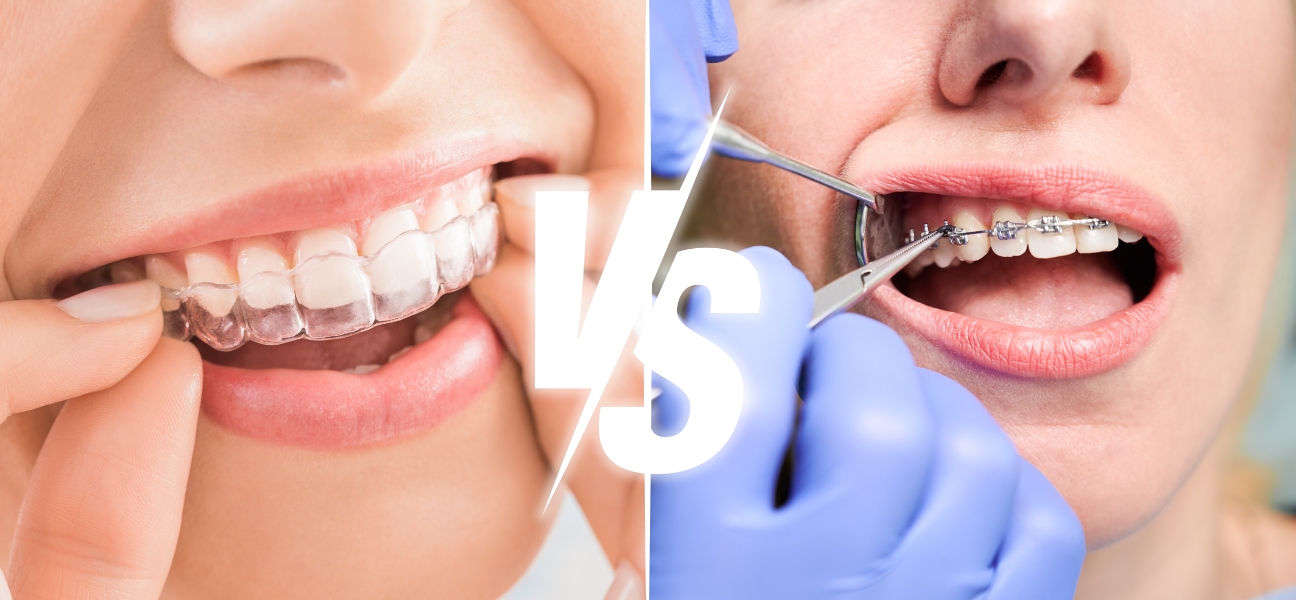Choosing between Invisalign and braces for teeth straightening can be a challenging decision. Both options offer effective ways to correct misaligned teeth and improve your smile. The better choice depends on your orthodontic needs, lifestyle, and personal preferences. So, what is better Invisalign or braces?
Invisalign uses clear, removable aligners that gradually shift your teeth into the desired position. Braces, on the other hand, consist of metal brackets and wires attached to your teeth. Each method has its own set of advantages and disadvantages, making it essential to consider factors like treatment duration, visibility, and maintenance requirements.
Your orthodontist or dentist can help you determine which option is best suited for your unique situation. They’ll consider factors such as the complexity of your case, your daily routines, and your budget. By understanding the pros and cons of each treatment, you’ll be better equipped to make an informed decision about your orthodontic care.
At Frankfort Smiles Dental, we are an Invisalign Gold Provider! Book a free consultation today with us!
Key Takeaways
- Your specific orthodontic needs and lifestyle influence whether Invisalign or braces are better for you
- Both Invisalign and braces effectively straighten teeth but differ in appearance, maintenance, and treatment process
- Consult with an orthodontist to determine the most suitable option for your unique case
Understanding Orthodontic Treatment Options
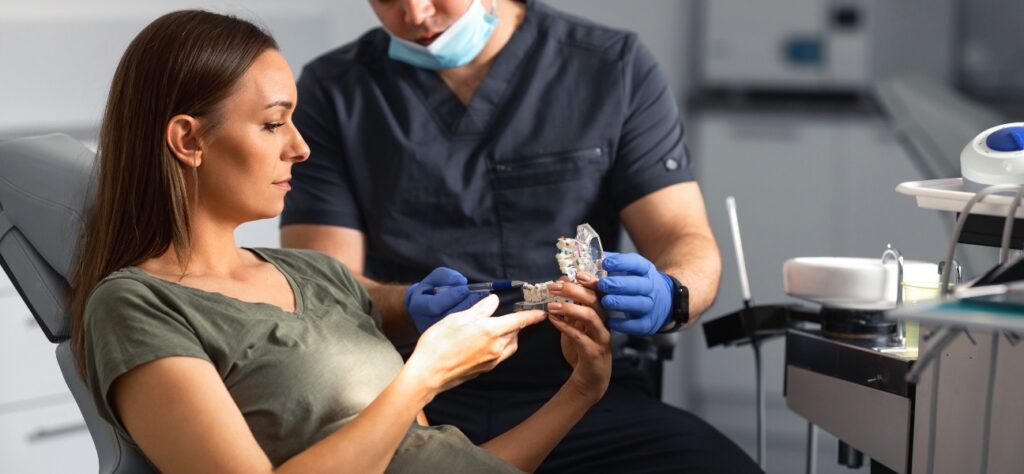
Orthodontic treatments have evolved to offer patients various choices for correcting dental misalignments. These options cater to different needs and preferences, providing effective solutions for achieving a straighter smile.
Traditional Braces
Traditional braces are a time-tested orthodontic treatment consisting of metal brackets and wires attached to your teeth. They apply constant pressure to shift your teeth into proper alignment gradually.
Metal braces are highly effective for complex cases and can treat many orthodontic issues. You can customize them with colored bands for a more personalized look.
Ceramic braces offer a less noticeable alternative, using tooth-colored or clear brackets. These blend in with your natural tooth color but function similarly to metal braces.
Lingual braces are another discreet option, with brackets placed on the back of your teeth. They’re completely hidden from view but may require a longer adjustment period.
Invisalign Clear Aligners
Invisalign clear aligners are a popular alternative to traditional braces. These custom-made, removable trays gradually shift your teeth into the desired position.
You’ll receive a series of aligners, each worn for about two weeks before moving to the next set. The clear plastic makes them nearly invisible, offering a more discreet treatment option.
Invisalign aligners are removable, allowing you to eat, brush, and floss without restrictions. This feature can make maintaining oral hygiene easier during treatment.
Treatment time with Invisalign may be shorter in some cases compared to traditional braces. However, their effectiveness depends on your commitment to wearing them for 20-22 hours daily.
Factors Affecting Treatment Selection
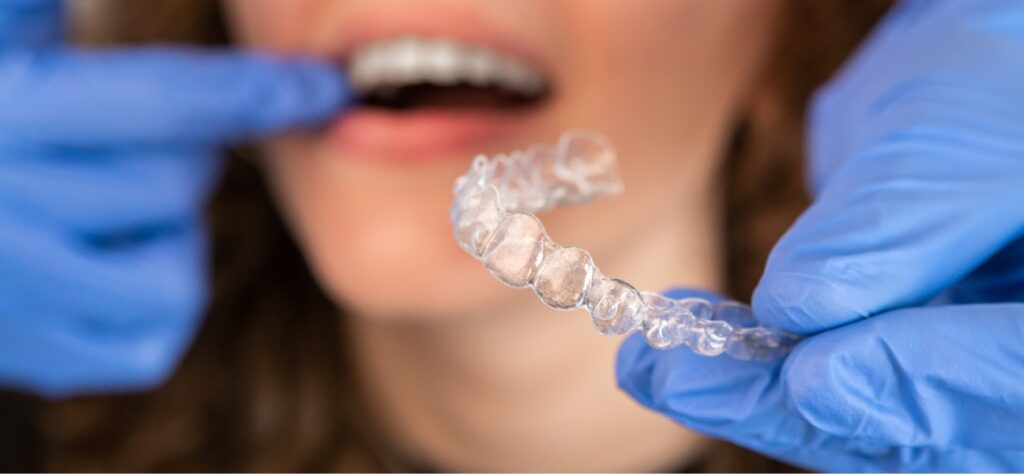
Choosing between Invisalign and braces involves considering several key aspects. Your decision will depend on personal preferences, lifestyle, and specific orthodontic needs. Meeting with your orthodontist or dentist can help you decide which option is best for you!
Esthetics and Appearance
Invisalign offers a nearly invisible orthodontic solution. The clear aligners are barely noticeable, making them popular for adults and teens concerned about their appearance during treatment. You can remove them for special occasions, providing flexibility.
Traditional braces are more visible but come in various options:
- Metal braces: Most noticeable but often the most affordable
- Ceramic braces: tooth-colored for a less conspicuous look
- Lingual braces: attached behind teeth, hidden from view
Your comfort level with visible orthodontic appliances will play a role in your choice. Some patients prefer the discreet nature of Invisalign, while others don’t mind the appearance of braces.
Treatment Time and Effectiveness
Treatment duration varies based on individual cases. Invisalign typically takes 12-18 months, while braces often require 18 months to 3 years. However, treatment times can differ depending on the complexity of your orthodontic issues.
Effectiveness considerations:
- Braces are fixed, working continuously without relying on patient compliance
- Invisalign requires you to wear aligners 20-22 hours daily for optimal results
- Complex cases may be better suited for traditional braces
Your lifestyle and ability to follow treatment guidelines will influence which option is more effective for you. Braces may be preferable if you’re concerned about forgetting to wear aligners consistently.
Cost Considerations
The cost of orthodontic treatment varies widely based on factors like treatment duration and complexity. Generally:
- Invisalign: $3,000 – $8,000
- Traditional braces: $2,500 – $6,000
Dental insurance coverage can significantly impact your out-of-pocket expenses. Some plans offer partial coverage for both Invisalign and braces, while others may only cover traditional braces.
Additional cost factors:
- Orthodontist’s experience and location
- Potential for additional procedures or refinements
- Retainers after treatment completion
Consider your budget and insurance coverage when making your decision. Some orthodontists offer payment plans to make treatment more affordable.
Examining Comfort and Convenience

Comfort and convenience play crucial roles in orthodontic treatment. The choice between Invisalign and braces can significantly impact your daily life and overall treatment experience.
Experience During Treatment
Invisalign offers superior comfort compared to traditional braces. The smooth plastic aligners reduce irritation to your cheeks and gums. You’ll experience less discomfort during adjustments, as you simply switch to a new set of aligners every 1-2 weeks.
Traditional braces, on the other hand, may cause initial soreness and irritation. The metal brackets and wires can rub against your inner cheeks and lips. You might need to use dental wax to alleviate discomfort.
Invisalign aligners are removable, so you can take them out for special occasions. This flexibility can be particularly appealing if you have important events or presentations.
Eating and Oral Hygiene
With Invisalign, you remove the aligners before eating. This means you can enjoy all your favorite foods without restrictions. Simply take out your aligners, eat, brush your teeth, and put them back in.
Braces require more careful consideration when eating. You’ll need to avoid hard, sticky, and chewy foods that could damage the brackets or wires. This might mean giving up some of your favorite snacks during treatment.
Oral hygiene is easier with Invisalign. You can brush and floss normally after removing your aligners. With braces, you’ll need to navigate around brackets and wires, which can be time-consuming and challenging.
Drinking and Staining
When considering Invisalign vs traditional orthodontic options, many people wonder about the impact of drinking and staining on their treatment. Invisalign aligners are made of clear plastic and are also known as invisible braces, offering a discreet alternative to braces. Unlike traditional metal braces with metal wires, Invisalign trays can be removed while eating and drinking, reducing the risk of staining.
However, it’s important to consider the pros and cons of Invisalign when deciding between Invisalign and traditional options. While Invisalign works to straighten your teeth through a series of clear aligners, they may not be suitable for all cases of crooked teeth. The cost of Invisalign is often more expensive than braces, but many find the convenience worth it.
Ultimately, whether you choose Invisalign or braces depends on your specific needs and preferences. Invisalign vs braces is a common debate, and neither option is always the best. Consult with your orthodontist to decide between Invisalign and other types of braces to determine which one is better for your situation and lifestyle.
Addressing Special Orthodontic Needs

Invisalign and braces can address various orthodontic issues, but their effectiveness may differ for specific dental conditions. The choice between these treatments depends on your unique needs and any sensitivities you may have.
Complex Malocclusions
For severe cases of malocclusion, traditional braces are often more effective. They can correct significant overbites, underbites, and severely crowded teeth. Braces apply constant pressure, making them ideal for rotating teeth or moving them vertically.
If you have a complex bite issue, your orthodontist may recommend braces with additional attachments. These can include elastics or headgear to address jaw alignment problems.
Invisalign has improved over the years and can now treat many complex cases. However, it may require additional attachments or longer treatment times for severe malocclusions.
Metal Allergies and Sensitivities
If you have metal allergies or sensitivities, Invisalign could be the perfect solution. The clear aligners are made of smooth plastic, eliminating the risk of allergic reactions or irritation from metal brackets and wires.
Ceramic brackets are an alternative for those with metal sensitivities who require traditional braces. These are less likely to cause allergic reactions while still providing effective treatment for complex cases.
If you grind your teeth, Invisalign aligners can act as a protective barrier. However, severe grinding may wear down the aligners faster, potentially increasing treatment costs.
Post-Treatment Considerations
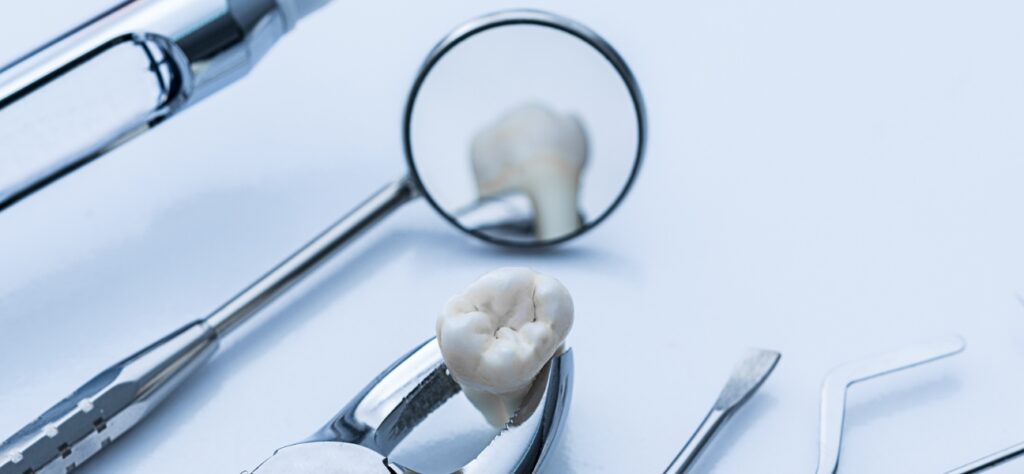
After completing your orthodontic treatment, it’s crucial to maintain your new smile and protect your dental health. Proper care and attention will ensure long-lasting results.
Retaining Your Perfect Smile
Wearing retainers is essential after Invisalign or braces treatment. You’ll need to wear them full-time initially, then transition to nighttime use. Retainers prevent teeth from shifting back to their original positions.
Clear plastic retainers are often preferred for their discreet appearance. They’re custom-made to fit your newly aligned teeth perfectly.
Regular dental exams are crucial during the retention phase. Your orthodontist will check your teeth’s alignment and adjust your retainer if needed.
Be diligent about wearing your retainer as instructed. Neglecting this step can undo the progress achieved with your orthodontic work.
Long-Term Dental Health
Properly aligned teeth contribute to better oral hygiene. You’ll find it easier to brush and floss effectively, reducing the risk of cavities and gum disease.
Regular dental check-ups are vital for maintaining your smile. Your dentist can spot potential issues early and provide necessary treatments.
Good oral habits are crucial. Brush twice daily, floss regularly, and avoid habits that may damage your teeth, such as nail-biting or using your teeth as tools.
Be mindful of hard foods that could potentially damage your teeth or any remaining orthodontic appliances. Protect your investment in your smile by being cautious with your diet.
Frequently Asked Questions: Invisalign vs Braces
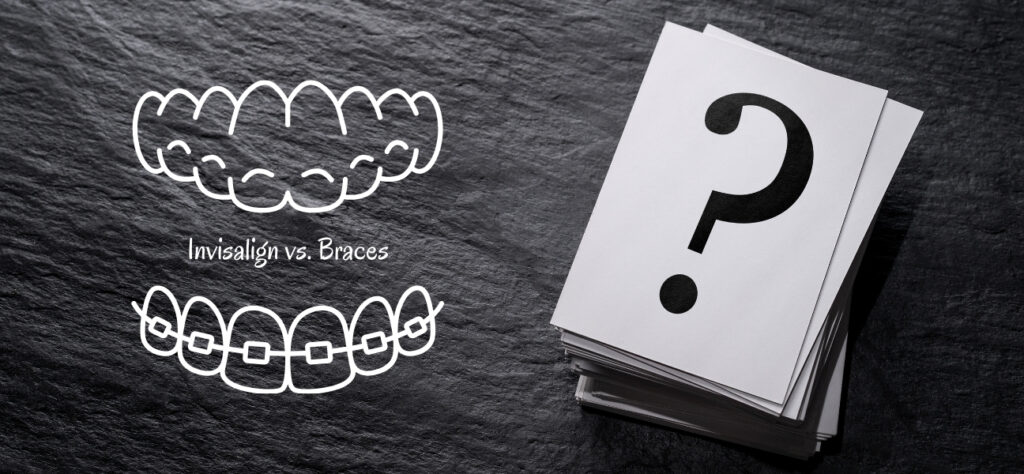
Choosing between Invisalign and braces involves considering various factors like appearance, cost, treatment duration, and effectiveness for specific alignment issues. Understanding the pros and cons of each option can help you make an informed decision.
What are the pros and cons of braces compared to Invisalign?
Braces offer effective treatment for complex alignment issues. They’re generally less expensive than Invisalign and don’t require as much self-discipline to wear consistently.
On the downside, braces are more visible and can cause discomfort. They also require dietary restrictions and more frequent orthodontist visits.
Invisalign provides a nearly invisible treatment option and allows for easier eating and oral hygiene. They’re often more comfortable than braces.
The main drawbacks of Invisalign include potentially higher costs and the need for strict compliance in wearing the aligners.
Are braces or Invisalign more suitable for adults?
Invisalign is often preferred by adults due to its discreet appearance. The clear aligners are less noticeable in professional settings.
Braces can be suitable for adults with complex alignment issues. Some adults opt for ceramic braces as a compromise between effectiveness and aesthetics.
Your lifestyle and specific dental needs will ultimately determine which option is best for you as an adult.
Can Invisalign treatment be more cost-effective than traditional braces?
While Invisalign is generally more expensive than traditional braces, it can be cost-effective in certain situations.
Invisalign often requires fewer orthodontist visits, potentially saving you time and associated costs. The treatment duration may also be shorter for some cases.
Consider your insurance coverage and payment plans when comparing costs. Some orthodontists offer similar pricing for both treatments.
How do I determine whether to choose braces or Invisalign?
Consult with an orthodontist to assess your specific dental needs. They can recommend the most suitable option based on the complexity of your case.
Consider your lifestyle, budget, and aesthetic preferences. Think about your ability to comply with treatment requirements, such as wearing Invisalign aligners for 20-22 hours daily.
Weigh the pros and cons of each option, including treatment duration, comfort, and effectiveness for your particular alignment issues.
What type of teeth alignment issues is Invisalign better suited for?
Invisalign is effective for mild to moderate alignment issues. It works well for crowding, gaps, and some bite problems.
Simple rotations and vertical movements of teeth are achievable with Invisalign. It’s particularly suitable for cases requiring subtle adjustments.
For complex issues like severe overbites or underbites, traditional braces may be more effective.
What differences in treatment outcomes can be expected between braces and Invisalign?
Both braces and Invisalign can achieve excellent results when used for appropriate cases. The outcomes largely depend on proper diagnosis and treatment planning.
Braces may offer more precise control for complex movements and can address severe misalignments more effectively.
Invisalign can provide comparable results for many cases, especially when compliance is high. Treatment time may be shorter for some Invisalign patients.

